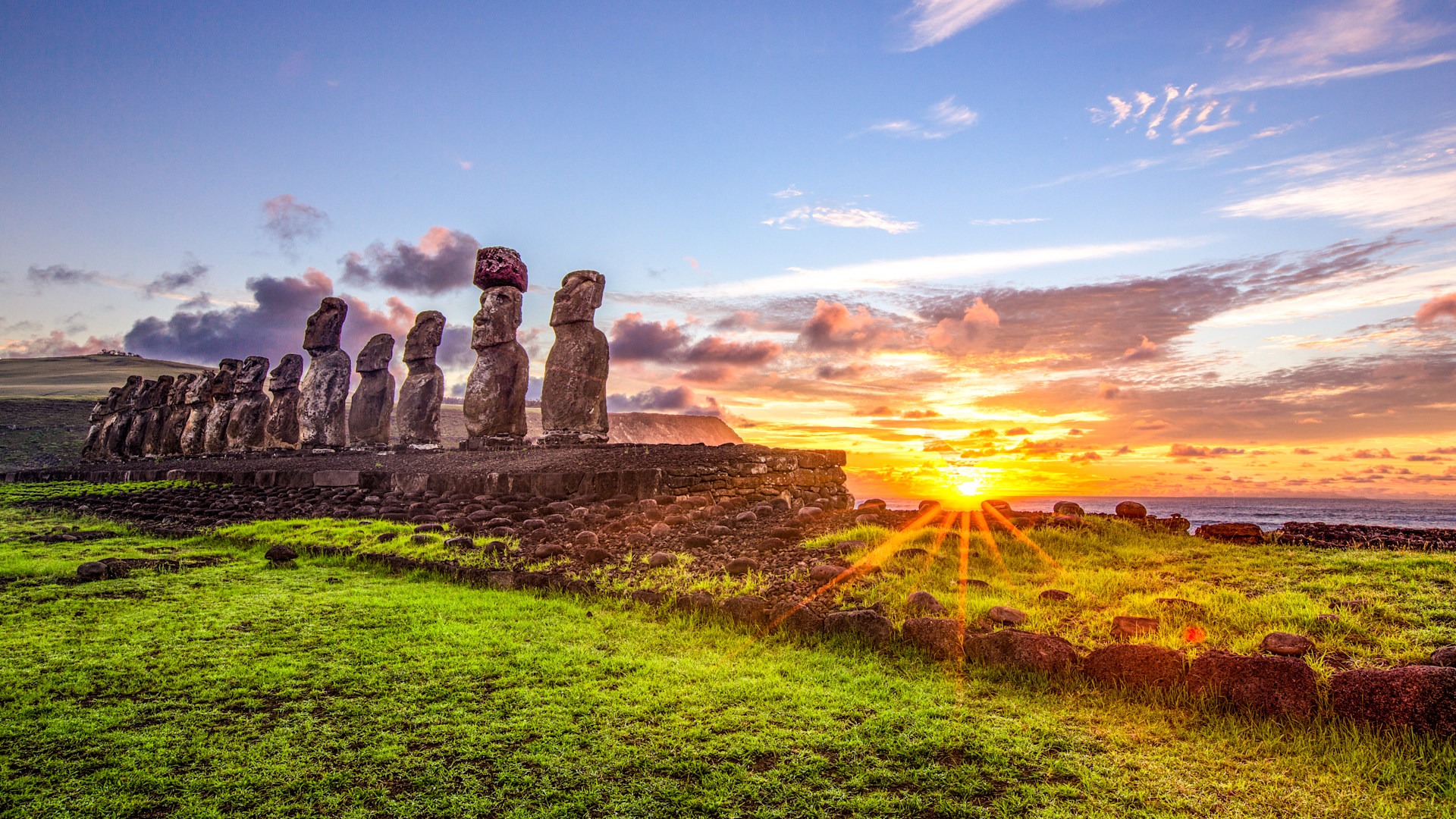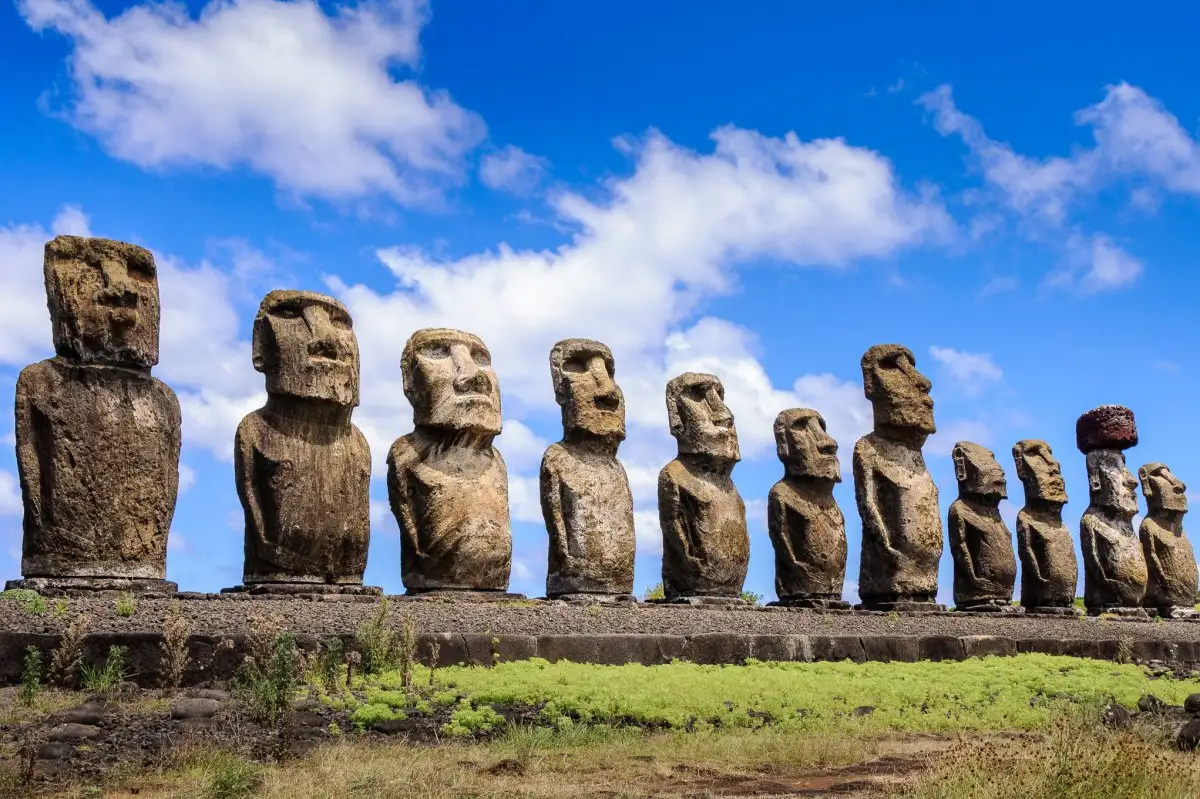



Easter Island, a Chilean territory, is a remote volcanic island in Polynesia. Its native name is Rapa Nui. It’s famed for archaeological sites, including nearly 900 monumental statues called moai, created by inhabitants during the 13th–16th centuries. The moai are carved human figures with oversize heads, often resting on massive stone pedestals called ahus. Ahu Tongariki has the largest group of upright moai.
Summer (December to February): The best time to visit Easter Island is during the summer months when the weather is warm, with temperatures ranging from 20°C to 30°C (68°F to 86°F). This period offers ideal weather for exploring the island’s archaeological sites and beaches.
Spring (September to November): Spring is a pleasant time to visit, with mild temperatures and fewer tourists. You may also experience blooming flora and vibrant landscapes.
Autumn (March to May): This season offers fewer crowds and still fairly warm temperatures, though occasional rain showers are possible. It’s a peaceful time to explore the island.
Winter (June to August): Winter brings cooler temperatures and more rain. It’s the least crowded time of year, so if you prefer a quiet visit and don’t mind cooler, wetter conditions, this might be the time for you.
By Air: The only way to reach Easter Island is by air. There are direct flights from Santiago (SCL) to Mataveri International Airport (IPC), the island's primary airport. The flight takes about 5 hours.
By Sea: While there are occasional cruises that visit Easter Island, there are no regular ferry services to the island, making air travel the most common and efficient option.
Moai Statues: The most iconic feature of Easter Island, the Moai statues are large stone monolithic figures scattered around the island. Ahu Tongariki (with 15 Moai) is one of the most impressive sites, along with Ahu Akivi and Rano Raraku, the quarry where most of the Moai statues were carved.
Rano Raraku: This volcanic crater and archaeological site is where the Moai statues were carved out of volcanic rock. It’s home to nearly half of the island’s statues, providing insight into the island’s ancient culture.
Ahu Tongariki: The largest ceremonial site on the island, featuring 15 standing Moai statues along the coastline, facing inland. The sunrise here is a magical experience.
Rapa Nui National Park: A UNESCO World Heritage site, this park encompasses much of the island’s archaeological sites, including Ahu Akivi, Puna Pau, and Rano Kau, a volcanic crater with stunning views.
Orongo Ceremonial Village: Located at the top of the Rano Kau crater, this village was the center for the Birdman Cult. You’ll find petroglyphs and stone houses that were used for ceremonies to honor the god of fertility.
Anakena Beach: A beautiful beach with white sand, turquoise waters, and a set of Moai statues. This is a great spot to relax and enjoy the natural beauty of the island.
Hiking: Easter Island offers numerous hiking trails, including the climb to Rano Kau for panoramic views, and the trail up Terevaka, the highest point on the island. You can also hike around the Rano Raraku quarry to explore the Moai statues.
Snorkeling and Diving: The island’s crystal-clear waters offer great opportunities for snorkeling and diving, especially around Anakena Beach and Ovahe Beach, where you can explore underwater volcanic landscapes and marine life.
Cultural Tours: Learn about the fascinating Rapa Nui culture, including the history of the Moai statues, the Birdman cult, and the island’s mysterious traditions. Many local guides offer cultural and archaeological tours.
Stargazing: Easter Island has some of the clearest skies in the world, making it a fantastic place for stargazing. You can see the Milky Way and other celestial wonders.
Horseback Riding: Explore the island's rugged terrain on horseback, which allows you to reach remote sites and enjoy the natural beauty of Easter Island at a slower pace.
Luxury: There are a few luxury options on the island, such as Explora Rapa Nui or Hotel Hanga Roa, both offering high-end amenities with beautiful ocean views.
Mid-range: For more budget-friendly options, try Hotel Vai Moana or Hotel Manavai, which offer comfortable accommodations with convenient access to the island’s attractions.
Budget: There are also hostels and guesthouses like Cabañas Anakena or Tupa Hotel, which provide more affordable stays for travelers.
Locally Caught Seafood: Fresh fish, including tuna and octopus, are staples on the island. Try dishes like Pescado a la Parrilla (grilled fish) at local eateries.
Curanto: A traditional dish of Easter Island, Curanto is made with seafood, meat, potatoes, and vegetables, often cooked in an underground oven. Enjoy it at restaurants like Te Moana or La Kaleta.
Rapa Nui Stew: A hearty, flavorful stew made with local ingredients, typically including lamb, potatoes, and various vegetables. It’s often served in local eateries and markets.
Restaurants: For dining options, try Café Rapa Nui, Tahitian Restaurant, or Haka Honu for a mix of traditional and international cuisine with fantastic views of the ocean.
Rapa Nui People: The island’s native inhabitants, known as the Rapa Nui, have a rich cultural heritage. Their language, art, music, and traditions are deeply connected to the island’s ancient history and the Moai statues.
The Birdman Cult: One of the island's most fascinating cultural aspects was the Birdman Cult. It centered around the competition to retrieve an egg from the Motu Nui islet, which is depicted at the Orongo Ceremonial Village.
Handicrafts: Local handicrafts such as wood carvings, textiles, and jewelry are popular souvenirs. Pablo Naranjo’s Workshop in Hanga Roa is a great place to find authentic handmade items.
Festivals: Easter Island celebrates various cultural festivals, including the Tapati Rapa Nui Festival, a vibrant annual event featuring traditional dances, music, and competitions, held in February.